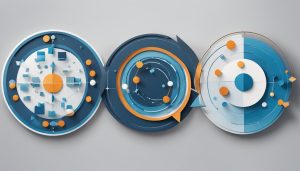Partitioning is an essential concept in construction projects, where large spaces are divided into smaller, more manageable units. It serves multiple purposes, including creating defined spaces, enhancing privacy and security, improving efficiency, and reducing noise. Different types of partitioning techniques, such as drywall partitioning, metal stud partitioning, and curtain wall partitioning, are used depending on the specific requirements of the project and design preferences.
Key Takeaways
- Partitioning refers to dividing large spaces into smaller, more manageable units in construction.
- Types of partitioning techniques include drywall partitioning, metal stud partitioning, and curtain wall partitioning.
- Partitioning enhances privacy and security, improves efficiency, and reduces noise.
- Partitioning offers customizability and helps in reducing energy costs.
- Understanding partitioning is essential in construction projects.
Why Is Partitioning Essential in Construction?
Partitioning plays a crucial role in construction projects, offering numerous benefits and serving various purposes. Whether it’s a commercial building, an office space, or a residential property, partitioning is essential for creating defined spaces, enhancing privacy and security, improving efficiency, and reducing noise.
One of the primary reasons why partitioning is vital in construction is that it allows for better space utilization and resource management. By dividing larger areas into smaller units, partitioning optimizes the available space, making it more functional and efficient. This is particularly important in commercial and office buildings where privacy and security are key concerns. Partitioning creates separate areas for different functions, such as offices, meeting rooms, or common areas, ensuring privacy and confidentiality for employees and clients.
Another significant advantage of partitioning is its flexibility. With various types of partitioning materials and techniques available, spaces can be easily customized to suit specific design preferences or functional requirements. Partition walls can be easily installed, removed, or reconfigured, allowing for easy adaptations and modifications as needs change over time. This flexibility ensures that a building’s layout can evolve with the growth and development of the business or organization.
Partitioning creates separate areas for different functions, ensuring privacy and confidentiality for employees and clients.
Furthermore, partitioning contributes to improved acoustics and noise reduction within a building. By introducing partition walls made of sound-absorbing materials, noise levels can be significantly decreased, providing a more comfortable and productive work environment. This is especially important in open-plan offices or shared spaces where noise can be a major distraction.
In summary, partitioning is essential in construction due to its ability to create defined spaces, enhance privacy and security, improve efficiency, and reduce noise levels. It offers flexibility in space utilization and customization, ensuring that the building layout can adapt to changing needs. Additionally, partitioning contributes to better acoustics and noise reduction, promoting a more comfortable and productive environment. Whether it’s a commercial building or a residential property, partitioning plays a crucial role in optimizing space and creating functional and aesthetically pleasing interiors.
Types of Construction Partitioning
In construction, partitioning is a crucial process that involves dividing large spaces into smaller, more manageable units. There are various types of partitioning techniques used in construction, each with its own advantages and applications. Let’s explore the three most common types of construction partitioning: drywall partitioning, metal stud partitioning, and curtain wall partitioning.
Drywall Partitioning
Drywall partitioning, also known as gypsum board partitioning, is a popular choice in construction. It involves creating walls using gypsum boards, which are lightweight, cost-effective, and easy to install. Drywall partitioning offers good sound insulation, making it suitable for spaces where noise reduction is important, such as office areas and conference rooms.
Metal Stud Partitioning
Metal stud partitioning is another widely used method in construction. It utilizes lightweight metal studs and tracks to create walls and partitions. Metal stud partitioning is known for its durability and flexibility, allowing for easy customization and reconfiguration of spaces. It is commonly used in commercial buildings, hospitals, and educational institutions.
Curtain Wall Partitioning
Curtain wall partitioning involves creating glass walls to allow natural light to flow into the space. It offers an open and modern aesthetic, making it a popular choice for contemporary office spaces and commercial buildings. Curtain wall partitioning provides visual transparency and can enhance the overall design of a building while maintaining privacy and noise reduction.
| Partitioning Type | Advantages | Applications |
|---|---|---|
| Drywall Partitioning | Cost-effective, lightweight, good sound insulation | Office areas, conference rooms |
| Metal Stud Partitioning | Durable, flexible, easy customization | Commercial buildings, hospitals, educational institutions |
| Curtain Wall Partitioning | Natural light, modern aesthetic, privacy | Contemporary office spaces, commercial buildings |
Each type of construction partitioning has its own unique advantages and applications. The choice of partitioning technique depends on factors such as the desired aesthetics, sound insulation requirements, and budget constraints. By understanding the different types of construction partitioning available, architects and construction professionals can make informed decisions to create functional and visually appealing spaces.
Benefits of Construction Partitioning
Construction partitioning offers a range of benefits that contribute to the overall functionality and efficiency of a building. These benefits include increased privacy and security, improved productivity, and reduced energy costs.
Increased privacy and security: Partitioning creates separate spaces within a building, enhancing privacy and security. By dividing larger areas into smaller units, partitioning allows for the creation of private rooms or offices, keeping sensitive information confidential and reducing the risk of unauthorized access.
Improved productivity: Partitioning provides designated areas for specific tasks, allowing for better concentration and focus. By creating quiet and separate workspaces, partitioning minimizes distractions and interruptions, ultimately improving overall productivity and efficiency.
Reduced energy costs: Partitioning can optimize the heating, ventilation, and air conditioning (HVAC) systems within a building. By dividing spaces into smaller units, it becomes easier to control the temperature and airflow in each area. This targeted control leads to reduced energy consumption and lower operating costs.
Table: Comparing the Benefits of Construction Partitioning
| Benefits | Description |
|---|---|
| Increased privacy and security | Partitioning creates separate, private spaces within a building, enhancing confidentiality and protecting sensitive information. |
| Improved productivity | Partitioning provides designated workspaces, reducing distractions and interruptions to improve concentration and efficiency. |
| Reduced energy costs | Partitioning allows for targeted control of HVAC systems, optimizing temperature and airflow to minimize energy consumption. |
Overall, construction partitioning offers practical solutions to enhance privacy, increase productivity, and save on energy costs. Whether it’s creating separate office spaces, dividing larger rooms into functional areas, or optimizing HVAC systems, partitioning is an essential element in modern construction.
How Partitions Can Enhance the Structure and Function of a Building
Partitions play a crucial role in improving the structure and function of a building, offering a range of benefits that enhance privacy, space utilization, flexibility, soundproofing, acoustics, and aesthetics.
Improved privacy and comfort are key advantages of partitions. By dividing spaces into separate rooms, partitions create private areas, allowing individuals to work, relax, or engage in activities without interruption or distractions. This increased privacy fosters a sense of comfort and personal space in shared environments.
Furthermore, partitions enable better use of space within a building. They allow for the division of larger rooms into smaller, more functional areas, optimizing the layout and ensuring efficient utilization of available space. This flexibility is particularly beneficial in commercial settings where adaptable spaces are essential for accommodating changing needs and activities.
“Partitions provide improved privacy and comfort by dividing spaces into separate rooms.”
Another advantage of partitions is their ability to enhance soundproofing and acoustics. By reducing noise levels and optimizing room acoustics, partitions contribute to a quieter and more comfortable environment. This is especially important in offices, educational institutions, and healthcare facilities where minimizing noise disturbances is crucial for productivity, concentration, and well-being.
Lastly, partitions can significantly improve the aesthetics of a building. They come in various designs, materials, and finishes that can complement the overall interior design and create visually striking features. Whether it is sleek glass partitions, elegant wood panels, or modern metal frames, partitions can enhance the aesthetic appeal of a space and create a visually pleasing environment.
Overall, partitions offer numerous benefits in terms of improved privacy and comfort, better use of space, increased flexibility, enhanced soundproofing and acoustics, and improved aesthetics. They are a valuable addition to any building, providing practical and aesthetic advantages that contribute to a functional, inviting, and visually appealing space.
Different Types of Partitions Used in Construction: Pros, Cons, and Their Applications
Drywall Partitions
Drywall partitions are a popular choice in construction due to their ease of installation and affordability. They involve using gypsum boards to create walls, providing good sound insulation and a smooth finish. Drywall partitions are versatile and can be easily customized to fit specific design preferences or functional requirements. However, they may not be suitable for areas with high humidity or fire-resistant requirements, as moisture can damage the boards and they are not inherently fire-resistant.
Glass Partitions
Glass partitions offer a modern and stylish look, allowing natural light to flow through spaces and creating an open and airy feel. They are easy to clean and maintain, making them a popular choice for offices, showrooms, and modern interiors. Glass partitions can enhance the visual aesthetics of a building and create a sense of transparency. However, they can be more expensive compared to other partition types and may compromise privacy as they are transparent. Additionally, glass partitions may not provide the same level of sound insulation as other materials.
Brick Partitions
Brick partitions are known for their strength, durability, and fire resistance. They offer excellent sound insulation and are commonly used in industrial or commercial buildings where noise reduction is crucial. Brick partitions are less flexible compared to other types and may require more time and effort for installation. They are typically more expensive due to the cost of materials and labor. Brick partitions are suitable for creating permanent structures that require high levels of strength and fire resistance.
Moveable Partitions
Moveable partitions provide flexibility and versatility in creating different layouts and dividing spaces as needed. They are highly customizable, allowing for easy reconfiguration of rooms to adapt to changing needs. Moveable partitions can be made of various materials, including gypsum boards, glass, or fabric, depending on the desired aesthetics and functional requirements. However, they may have limitations in terms of sound insulation compared to other partition types. Moveable partitions are commonly used in spaces that require frequent changes in layout, such as conference rooms, exhibition halls, or multipurpose areas.
In summary, different types of partitions offer various advantages and are suitable for different applications. Drywall partitions are affordable and easy to install, while glass partitions provide a modern and transparent look. Brick partitions offer strength and fire resistance, while moveable partitions provide flexibility and reconfigurability. Choosing the right type of partition depends on factors such as budget, design preferences, functional requirements, and the specific needs of the space being partitioned.
What is Database Partitioning and Its Advantages
Database partitioning, also known as data partitioning, is a technique used in database management to enhance scalability, availability, and performance. It involves breaking down a database into separate partitions, allowing for efficient data storage and retrieval. The advantages of database partitioning are numerous, making it a valuable strategy in modern data management.
One of the key advantages of database partitioning is improved scalability. With partitioning, data can be distributed across multiple servers, enabling horizontal scaling to handle growing data volumes and user demands. This ensures that the database can handle increased workloads without compromising performance or availability.
Another advantage of database partitioning is improved availability. By replicating data across multiple partitions, the system achieves redundancy, reducing the risk of a single point of failure. In the event of a hardware or software failure, the data remains accessible from other partitions, ensuring system uptime and minimizing the impact of disruptions.
Furthermore, database partitioning can significantly improve performance. By dividing data into smaller subsets, queries can be executed selectively on specific partitions instead of the entire database. This reduces contention and optimizes query response times, leading to faster and more efficient data retrieval. Additionally, partitioning enables data to be stored based on usage patterns, allowing for better data organization and retrieval efficiency.
| Advantages of Database Partitioning |
|---|
| Improved scalability |
| Improved availability |
| Improved performance |
Database partitioning offers significant advantages in terms of scalability, availability, and performance. By distributing data across multiple partitions, it allows for efficient data management and retrieval. Whether it is handling large data volumes, ensuring high availability, or optimizing query performance, database partitioning is a valuable strategy for modern data-intensive applications.
Database Partitioning in Action
Let’s consider a scenario where an e-commerce platform is experiencing a rapid increase in the number of users and transactions. Without database partitioning, the system may encounter performance bottlenecks and struggle to handle the growing workload.
By implementing database partitioning, the e-commerce platform can distribute user and transaction data across multiple partitions. This allows for parallel processing and fast retrieval of relevant data, ensuring that the system can handle high volumes of concurrent user requests without compromising performance.
Additionally, database partitioning enhances availability. In the event of a server failure or system maintenance, the platform can continue serving users by automatically accessing data from other available partitions. This ensures minimal disruption to the user experience and helps maintain the platform’s credibility and reputation.
Conclusion
In conclusion, partitioning is an essential technique in construction that offers numerous benefits. By dividing large spaces into smaller, more manageable units, partitioning creates defined spaces, enhances privacy and security, improves efficiency, and reduces noise. Different types of partitioning, such as drywall, metal stud, and curtain wall partitioning, provide various advantages and applications, allowing for customization based on specific needs and design preferences.
Furthermore, partitioning plays a crucial role in database management. Database partitioning, also known as data partitioning, enables improved scalability, availability, and performance by breaking data into separate partitions. This technique allows for horizontal scaling, ensuring that the database can handle growing demands. It also enhances availability through data replication and optimizes performance by reducing contention and optimizing data storage according to usage patterns.
Despite the complexities and additional costs associated with partitioning, both in construction and database management, the benefits it offers make it a valuable technique. Whether in creating functional spaces, enhancing privacy and security, or improving scalability and performance in databases, partitioning proves to be a valuable asset in various industries and applications.
FAQ
What is partitioning in construction?
Partitioning refers to the process of dividing large spaces into smaller, more manageable units in construction. It creates defined spaces, enhances privacy and security, improves efficiency, and reduces noise.
Why is partitioning essential in construction?
Partitioning is essential in construction because it creates defined spaces, enhances privacy and security, improves efficiency, and reduces noise. It allows for better space utilization and resource management, particularly in commercial and office buildings where privacy and security are key concerns.
What are the types of construction partitioning?
The types of construction partitioning include drywall partitioning, metal stud partitioning, and curtain wall partitioning. Each type has its own advantages and is suitable for different applications and design preferences.
What are the benefits of construction partitioning?
The benefits of construction partitioning include increased privacy and security, improved productivity, customizability, and reduced energy costs. It allows for the creation of private spaces, provides quieter areas for concentration, enables customization according to specific functions or design preferences, and optimizes energy consumption.
How can partitions enhance the structure and function of a building?
Partitions can enhance the structure and function of a building by providing improved privacy and comfort, better use of space, increased flexibility, better soundproofing and acoustics, and improved aesthetics.
What are the different types of partitions used in construction, and what are their pros and cons?
The different types of partitions used in construction are drywall partitions, glass partitions, brick partitions, and moveable partitions. Drywall partitions are affordable and offer good sound insulation, but they are not suitable for humid or fire-resistant areas. Glass partitions provide a modern look and allow natural light, but they can be more expensive and less private. Brick partitions are strong and fire-resistant but are more expensive and less flexible. Moveable partitions offer flexibility in creating different layouts but may have limitations in sound insulation.
What is database partitioning and its advantages?
Database partitioning, also known as data partitioning, involves breaking the data in an application’s database into separate partitions for improved scalability, availability, and performance. It allows for horizontal scaling, ensures high availability through data replication, and improves performance by optimizing data storage based on usage patterns.
Claudia loves to discover the world and conquer new software products every now and then.


